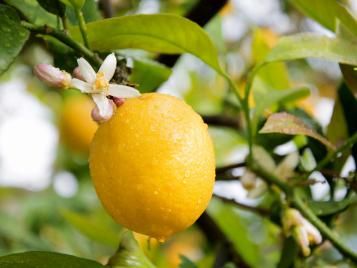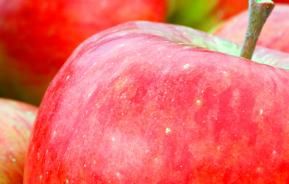Just imagine the scene: You want a gin and tonic or need some lemon juice for a recipe and you’ve run out of lemons. Then, you just pop out into the garden and pick your own! It sounds unbelievable – but it’s possible.
Lemons are a variety of Citrus, which grow on attractive, ornamental evergreen trees, usually reaching a height of up to 1.8m (6ft). They are not reliably cold hardy in Britain, so are best grown outside in containers from late spring/early summer to the beginning of autumn, and then brought inside for the winter.
Lemon trees produce lovely, white, fragrant flowers that may appear all year round, but more profusely during late winter. The fruit ripens in around 12 months, so trees may be in flower and fruit at the same time. They are self-fertile, so you will only need to grow one tree to get fruit.
They don’t make great houseplants, as they need plenty of light and most rooms – apart from a conservatory – aren’t really light enough or suitable. They dislike central heating, as this makes rooms too hot and stuffy with a lack of essential humidity.
Other citrus you can grow at home include oranges and limes.
How to grow lemons
Cultivating lemons
Lemon trees need a warm, sunny, sheltered position outdoors in summer (mainly from early to mid-June until the end of August in most parts of Britain) and a well-lit position indoors for autumn, winter and spring – preferably a cool greenhouse or conservatory.
Lemon trees ideally need a minimum temperature of 10°C (50°F); temperatures below 7°C (45°F) can severely damage or even kill the plants.
Keep some horticultural fleece to hand to protect plants if sudden cold nights below the minimum temperatures occur.
For optimal lemon tree growing conditions, grow in large, heavy containers using John Innes No.3 compost or a proprietary citrus compost.
Lemon varieties
Most suppliers just sell un-named ‘lemon trees’, but you can buy specific varieties from specialist citrus nurseries, such as The Citrus Centre.
- Meyer: compact and reliable, the fruit is very thin skinned and has a sweet flesh.
- Garey’s Eureka: reliable variety, the fruit is rough skinned.
- Four Seasons: a popular variety and good, flowers several times a year to give year-round fruit.

How to care for a lemon tree
Lemon trees are best bought in spring or early summer, giving them time to acclimatise to your conditions before the onset of autumn.
Water plants freely in summer, but never allow the pot to stand in water. Water more moderately from autumn to spring, allowing the compost surface to partially dry out between watering. Overwatering in winter is one of the commonest problems. Citrus don’t like very alkaline conditions, so use rainwater or de-ionised water if your tap water is very limey (hard). And, as they don’t like cold conditions and cold shocks to the roots, always use tepid water.
Mist the leaves in early morning in summer. Indoors, stand pots on trays of moist hydroleca or Hortag to help increase humidity. Mist plants regularly in winter to help ensure good pollination and fruit set.
All citrus are hungry plants and need good feeding. Use a high-nitrogen liquid feed plus trace elements from March-July. Then change to a balanced feed with trace elements until October. Specialist citrus feeds are a good choice and are available from garden centres selling citrus plants.
Pruning lemon trees
Lemon trees don’t need much pruning, but can be reshaped if necessary in late winter by thinning out overcrowded branches. At the same time tall stems can be cut back to encourage more bushy growth lower down. Tall, leggy plants can be pruned back by up to two-thirds into strong, leafy growth.
Throughout summer, pinch back the tips of vigorous growth with thumb and forefinger to encourage bushy growth and more flowers.
When pruning, be careful to avoid their vicious thorns.
Small trees up to 90cm (3ft) high may need fruit thinning to reduce the number of fruit to no more than 20.
Repotting lemon trees
If plants need repotting into a larger container, this is best done in spring. But only repot when they outgrow their current container.
In years when repotting is not necessary, remove the top 2.5-5cm (1-2in) of compost and replace it with fresh John Innes No.3 compost or citrus compost.
Harvesting lemons
The fruit develops a rich skin colour when fully grown and ready to pick, but it can also be left on the tree for longer if necessary.
Common lemon tree problems
Citrus can succumb to the following problems…
- Leaf yellowing: excessively wet or dry compost; low temperatures; draughts; lack of nutrients.
- Leaf fall: low temperatures; draughts, high temperatures in winter; overwatering.
- Flower failure: poor/low light levels, lack of nutrients; erratic watering; low temperatures.
- Poor fruit set: dry compost; low humidity.
| Flowering season(s) | Spring, Summer, Autumn, Winter |
|---|---|
| Foliage season(s) | Spring, Summer, Autumn, Winter |
| Sunlight | Full sun |
| Soil type | Loamy |
| Soil pH | Neutral |
| Soil moisture | Moist but well-drained |
| Ultimate height | Up to 1.8m (6ft) |
| Ultimate spread | Up to 1.5m (5ft) |
| Time to ultimate height | 10-15 years |








